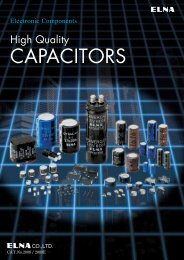Aluminum Electrolytic Capacitors
Aluminum Electrolytic Capacitors
Aluminum Electrolytic Capacitors
You also want an ePaper? Increase the reach of your titles
YUMPU automatically turns print PDFs into web optimized ePapers that Google loves.
®ALUMINUM ELECTROLYTIC CAPACITORS(1)Appearance : Check if there is any open valve orleakage.(2)Electronic performance : Check the leakagecurrent, the electrostatic capacitance, the tangentof loss angle and other items described in thecatalog or the product specifications.4. Take the following measures in case of emergency.• If you see gas coming out of the capacitor valvewhen the set is in operation, turn off the powerswitch of the unit or unplug the power cord fromthe outlet.• Keep your face away from the capacitor pressurevalve, since the high temperature gas at over100°C bursts out when the valve works. If the gasgets into your eyes or your mouth, wash your eyesor your mouth. Do not ingest the capacitor electrolyte.If the electrolyte gets on your skin, wash it outwith soap.5. Storing conditions.• Avoid high temperature or high humidity whenstoring capacitors. Keep the storing temperature at5 to 35 and the relative humidity not more than75%.• The leakage current of an aluminum electrolyticcapacitor tends to increase when stored for a longtime. This tendency becomes more prominent if theambient temperature is high. The leakage currentwill be decreased by voltage application. Ifnecessary, treatment by voltage application shouldbe made on the capacitors which have been storedfor a long period (more than 2 years afterproduction).• Do not store capacitors at a place where there isa possibility that they may get water, salt or oil spill.• Do not store capacitors at a place where the aircontains dense hazardous gas (hydrogen sulfide,sulfurous acid, nitrous acid, chlorine, ammonia,etc.).• Fumigation treatment with toxic gas covering thewhole wooden container frames as moth proofingduring shipment may leave residual toxic gas.• Do not store capacitors at a place where it getsultraviolet or radioactive rays.6. Disposing of capacitors.• Punch a hole or crush the capacitors (to preventexplosion) before incineration at approved facility.• If they are not to be incinerated, bring them to aprofessional industrial waste disposal company.7. Other notes.• Please refer to the following literature for anythingnot described in the product specifications or thecatalog.(Technical report of Japan Electronics and InformationTechnology Industries Association, EIAJ RCR-2367C“Guideline of notabilia for fixed aluminum electrolyticcapacitors for use in electronic equipment”)CAT.No.2010/2011Ea






